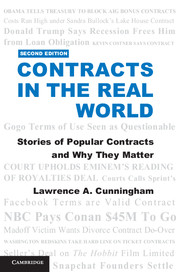Book contents
- Frontmatter
- Dedication
- Contents
- Annotated Contents
- Acknowledgments
- Introduction
- 1 Getting In: Contract Formation
- 2 Facing Limits: Unenforceable Bargains
- 3 Getting Out: Excuses and Termination
- 4 Paying Up: Remedies
- 5 Rewinding: Restitution and Unjust Enrichment
- 6 Writing It Down: Interpretation, Parol, Frauds
- 7 Performing: Duties, Modifi cation, Good Faith
- 8 Hedging: Conditions
- 9 Considering Others: Third Parties and Society
- Conclusion
- Appendix A Offering and Accepting
- Appendix B Buying and Selling Goods
- Notes
- Table of Cases
- Index
Appendix A - Offering and Accepting
Published online by Cambridge University Press: 05 March 2016
- Frontmatter
- Dedication
- Contents
- Annotated Contents
- Acknowledgments
- Introduction
- 1 Getting In: Contract Formation
- 2 Facing Limits: Unenforceable Bargains
- 3 Getting Out: Excuses and Termination
- 4 Paying Up: Remedies
- 5 Rewinding: Restitution and Unjust Enrichment
- 6 Writing It Down: Interpretation, Parol, Frauds
- 7 Performing: Duties, Modifi cation, Good Faith
- 8 Hedging: Conditions
- 9 Considering Others: Third Parties and Society
- Conclusion
- Appendix A Offering and Accepting
- Appendix B Buying and Selling Goods
- Notes
- Table of Cases
- Index
Summary
Many stories of contracts involve a formal dance that proceeds from one side reaching out with an opportunity to make a deal and the other responding, favorably or not. Contract law contains corresponding tools, describing steps such as offer, acceptance, rejection, and counteroffer. Even when real-world behavior does not neatly follow those steps, such tools aid analysis.
The text contains several stories illustrating some steps in the process, recapped here along with a few additional steps. References below to R2 are to the Restatement (Second) of Contracts, the synthesis on the common law of contracts prepared by the American Law Institute, a learned society of lawyers.
Formation. Contract formation requires consideration and manifestations of mutual assent. R2 § 17(1). A common legal approach to determining whether mutual assent and consideration are present is through a process that looks for an offer and an acceptance. An offer is a manifestation by a person (the offeror) of willingness to enter into a bargain, made in a way that justifies another (the offeree) to understand that assent to it is invited and will conclude it. R2 § 24. An offer creates in the offeree a power of acceptance. Effective exercise of the power of acceptance forms a contract.
Offers. A threshold issue is whether manifestations amount to offers. Requisite manifestation of willingness to enter into a bargain must appear. Expressions that do not amount to offers may instead be mere invitations to negotiate, advertisements, or preliminary negotiations. R2 § 26.
Master of the Offer. A common law slogan announces that the offeror is “master of the offer.” This phrase captures the idea that the offeror proposes the terms of bargain. Terms indicate what exchange is sought, including, for example, a return promise (offers for bilateral contracts) or an act of performance (offers for unilateral contracts). R2 § 30. It also captures how the offeror's manifestations determine to whom an offer is made, which can be one or multiple persons. R2 § 29.
The slogan traditionally also captured a common law idea that let the offeror specify the authorized mode of acceptance – steps that an offeree must take to exercise the power of acceptance. Although still the law, standards have been relaxed to treat offers as inviting acceptance by any means reasonable in the circumstances, unless the offer clearly states otherwise. R2 § 36.
- Type
- Chapter
- Information
- Contracts in the Real WorldStories of Popular Contracts and Why They Matter, pp. 243 - 246Publisher: Cambridge University PressPrint publication year: 2016



